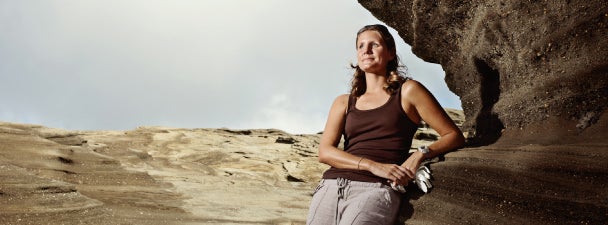
For most of us, getting close to a fiery lava flow may seem like an extreme occupational hazard. But for Andrea Steffke ’01, it’s just part of the job.
In fact, the volcanologist has little use for solid ground. She finds her footing instead on earth, or – more precisely – mountains, in flux.
“You can actually see the earth being made,” says Steffke, whose fascination with volcanoes began at the College, where she majored in geology.
Since graduation, she hasn’t missed a step: Steffke earned her master’s degree at the University of Alaska in Fairbanks and her Ph.D. at the University of Hawaii in Manoa, and she’s lived in arctic extremes and tropical paradises along the way – peering over the edge of a volcano’s vent into its mysterious depths and traveling far and wide to study volcanoes with names like Bezymianny and Ruapehu, Kilauea and Etna. Now, she serves as a post-doctoral fellow at the Hawaii Institute of Geophysics and Planetology in Manoa.
“Hawaiian volcanoes are relatively safe,” Steffke says, because they’re “flowing on relatively low-angle slopes.”
Basically, if the lava were to chart a course toward her toes, she’d have plenty of time to move out of the way. “However, you better stand upwind of the lava flow,” she warns, as its 900-degree centigrade heat could scorch the skin.
Though less dangerous than sampling lava, Steffke’s daily research is no less fascinating. “A mountain will emit a certain amount of energy,” she says, explaining that her challenge is to monitor that energy using field research and data beamed down to earth from NASA and NOAA satellites. While many volcanoes are monitored seismically, Steffke says, “the more tools you have to monitor them, the better.”
In one project, she monitors temperature increases along a volcano’s surface, signs that volcanic activity may be intensifying. In another, she compares the height of an eruption’s ash plume to the intensity of its pressure waves. Such findings could help aircraft avoid hazards, such as the one produced by the Icelandic volcano Eyjafjallajokul earlier this year. Perhaps more importantly, however, her findings could help volcano-side communities better prepare for the molten surprises that sometimes destroy homes and claim lives. “Most of the communities that build in ‘red areas,’ or danger zones, are communities that have been there a really long time,” Steffke observes. “Usually in developing nations, that’s where the most fertile
soil is.”
While much of her research involves interpreting satellite data, whenever she gets the opportunity, she heads into the field. Hiking, enjoying nature and being in the company of friends and colleagues are what she savors most. “When you’re out there with a group of people, it’s not only educational, but it’s also a lot of fun,” she says.
Of course, studying volcanoes isn’t just fun and games: For Steffke, tuning in to the powerful, yet often imperceptible, energy of volcanoes is all in a day’s work.
– Jamie Self ’02




